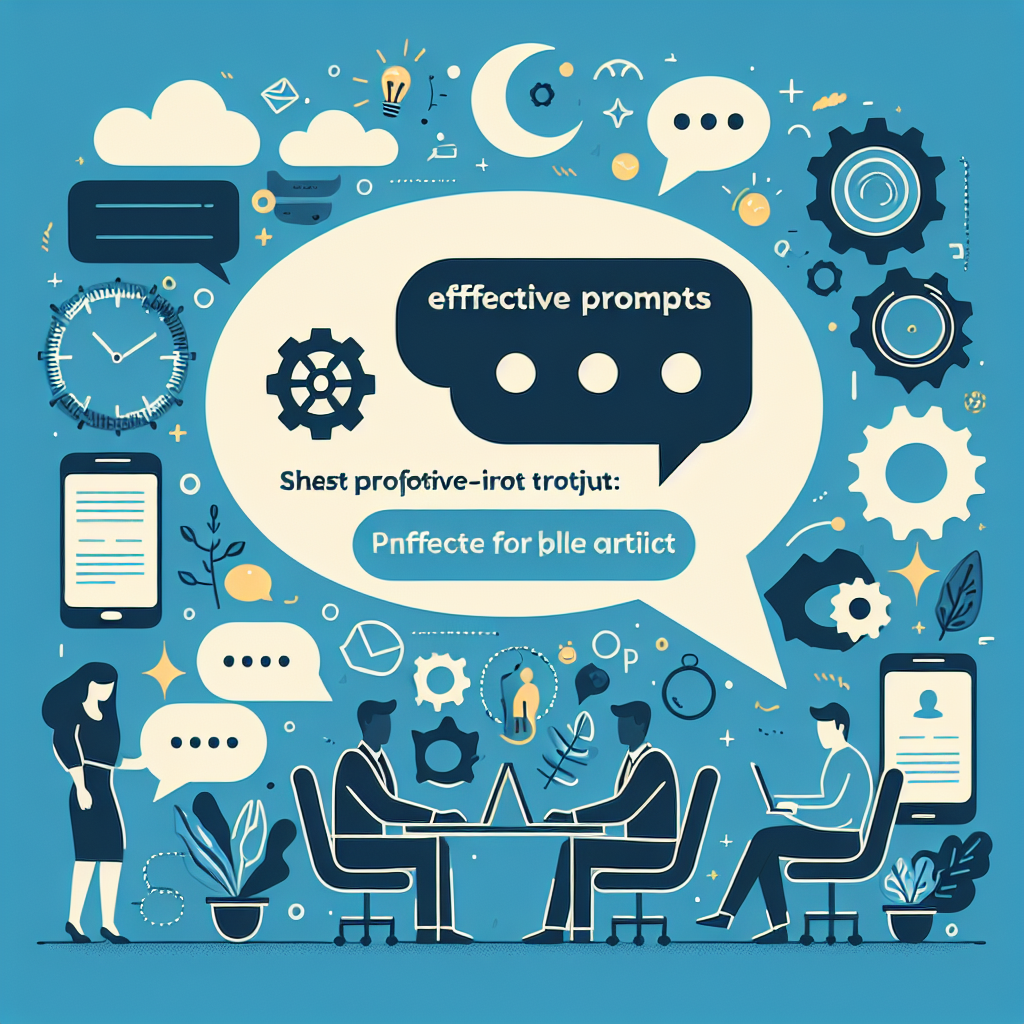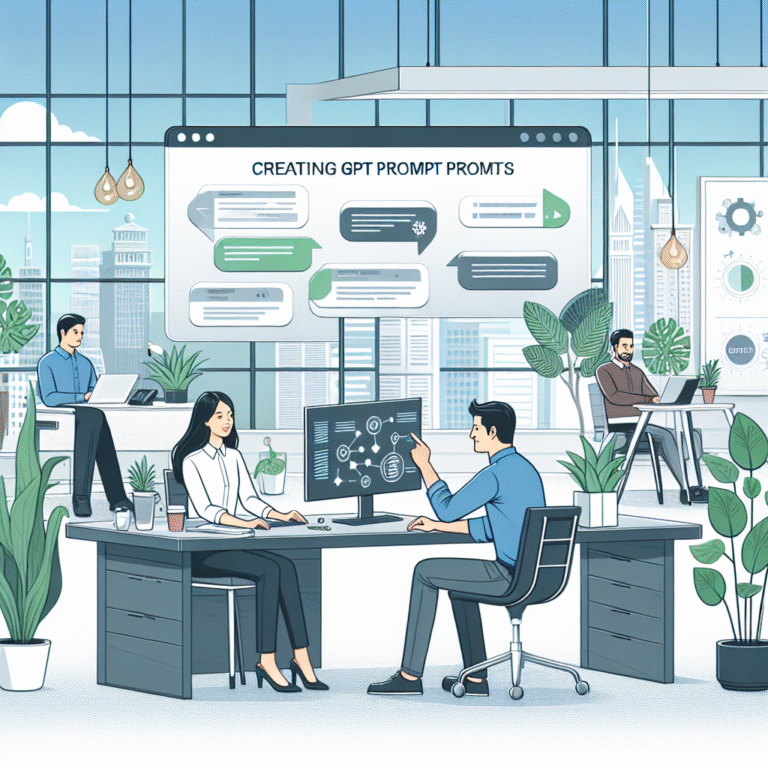Effective Prompts for ChatGPT: Unlocking the Power of AI Conversations
p>Effective prompts for ChatGPT are crucial in unlocking the full potential of this powerful AI tool. ChatGPT, with its advanced language generation capabilities, can provide detailed and informative responses to a wide range of questions and topics. However, the quality and relevance of these responses are heavily dependent on the prompts used to initiate the conversation. A well-crafted prompt can elicit a precise, accurate, and helpful response, while a poorly designed one can lead to confusion, misinterpretation, or even a completely irrelevant answer. Therefore, understanding how to construct effective prompts is essential for anyone looking to leverage ChatGPT for learning, research, content creation, or simply for engaging in productive and insightful conversations. This involves not just understanding the basics of prompt construction but also delving into the nuances of language, the specifics of the topic at hand, and the capabilities and limitations of the AI model itself. By mastering the art of crafting effective prompts, users can significantly enhance their experience with ChatGPT, gaining more value from their interactions and exploring the depths of what this technology can offer.<<
Understanding the Basics of Prompt Construction
 <<
<<
Constructing effective prompts for ChatGPT begins with a clear understanding of what the user is seeking to achieve or learn. This requires clarifying the topic, question, or task at hand. A good prompt should be specific, concise, and well-defined, providing ChatGPT with a clear direction and focus. It’s also important to consider the context in which the prompt is being used. For instance, if the goal is to generate creative content, the prompt might need to include parameters that encourage originality and imagination. On the other hand, if the aim is to gather factual information, the prompt should be designed to elicit accurate and reliable data. Additionally, users should be aware of the limitations and biases of the AI model, tailoring their prompts to work within these constraints and minimize potential pitfalls. By doing so, users can ensure that their interactions with ChatGPT are productive and yield the desired outcomes.<<
Specifying the Task or Question
<<
One of the key elements of an effective prompt is the clear specification of the task or question. This involves being as detailed as possible about what is being asked or required. For example, instead of asking ChatGPT to “write a story,” a more effective prompt might be “write a short science fiction story set in the year 2150, involving a character who discovers a hidden planet.” Such specificity guides ChatGPT in generating a response that meets the user’s expectations, reducing the likelihood of irrelevant or unsatisfactory outcomes. Furthermore, specifying the task or question helps in narrowing down the scope of the response, making it easier for ChatGPT to provide a focused and coherent answer. This approach not only enhances the quality of the interaction but also streamlines the process, saving time and effort for the user.<<
Delving into Nuances of Language
<<
The nuances of language play a significant role in the effectiveness of prompts for ChatGPT. The choice of words, the structure of the sentence, and even the tone and style of the prompt can significantly influence the response generated by the AI. For instance, using formal language might elicit a more professional and technical response, while a prompt written in an informal tone could result in a more conversational and casual answer. Understanding these nuances allows users to tailor their prompts to achieve the desired tone and style in the response, making the interaction more personalized and effective. Additionally, being mindful of linguistic nuances can help in avoiding ambiguities and ensuring that the prompt is interpreted as intended by ChatGPT, thereby reducing the risk of miscommunication and enhancing the overall quality of the interaction.<<
Considering Context and Domain Knowledge
<<
The context in which a prompt is used, along with the domain knowledge required, is crucial for eliciting relevant and accurate responses from ChatGPT. A prompt that is devoid of context or lacks specificity regarding the domain of knowledge may result in responses that are too general or not directly relevant to the user’s needs. For example, asking ChatGPT to explain “artificial intelligence” without specifying the context (e.g., historical development, applications, ethical considerations) could lead to a broad and perhaps not very useful response. By providing context and specifying the domain of interest, users can guide ChatGPT to delve deeper into the topic, offering insights and information that are directly applicable and valuable. This approach requires a good understanding of the subject matter and the ability to frame questions and tasks in a way that leverages ChatGPT’s capabilities effectively.<<
Practical Examples and Case Studies
 <<
<<
To illustrate the importance of effective prompts, let’s consider a few practical examples and case studies. For instance, in content creation, a prompt like “write a 500-word article on the benefits of meditation for mental health” can yield a comprehensive and well-structured piece that covers various aspects of the topic. In contrast, a vague prompt like “write about meditation” might result in a disjointed or superficial response. Similarly, in educational settings, using specific prompts that are aligned with learning objectives can help students engage more deeply with the material, facilitating a more effective learning experience. These examples highlight the significance of crafting prompts that are tailored to the specific needs and goals of the user, demonstrating how effective prompts can unlock the full potential of ChatGPT and enhance the quality of the interactions.<<
Real-World Applications
<<
The real-world applications of effective prompts for ChatGPT are diverse and extensive. In professional settings, well-crafted prompts can be used to generate reports, create content for marketing campaigns, or even assist in drafting legal documents. In educational contexts, prompts can be designed to facilitate interactive learning experiences, helping students to explore complex topics in a more engaging and personalized manner. Furthermore, for individuals looking to learn new skills or expand their knowledge on specific subjects, effective prompts can help in leveraging ChatGPT as a personal tutor or guide, providing tailored advice and information that caters to their unique needs and learning style. By recognizing the potential applications of effective prompts, users can explore new ways to integrate ChatGPT into their daily activities, enhancing productivity, learning, and creativity.<<
Step-by-Step Guide to Crafting Effective Prompts
<<
Crafting effective prompts for ChatGPT involves a systematic approach that considers the user’s goals, the context of the interaction, and the specifics of the topic or task at hand. The first step is to clearly define what is being asked or required, ensuring that the prompt is specific, concise, and well-defined. The next step involves considering the nuances of language and the tone or style desired in the response, tailoring the prompt to elicit the appropriate type of answer. Additionally, providing context and specifying the domain of knowledge can help in guiding ChatGPT to generate more relevant and accurate responses. Finally, refining the prompt based on the initial response, if necessary, can help in achieving the desired outcome. This iterative process allows users to fine-tune their prompts, maximizing the effectiveness of their interactions with ChatGPT and ensuring that they derive the most value from this powerful AI tool.<<
Refining Prompts Based on Feedback
<<
Refining prompts based on feedback is an essential part of the process, allowing users to adjust and improve their approach over time. This involves analyzing the responses generated by ChatGPT, identifying areas where the prompt might have been unclear or ineffective, and making adjustments accordingly. For example, if the response is too broad or does not directly address the question, the prompt might need to be more specific or detailed. Similarly, if the tone or style of the response does not match the user’s expectations, the prompt may require adjustments to better reflect the desired tone or style. By incorporating feedback into the prompt refinement process, users can develop a more nuanced understanding of how to effectively interact with ChatGPT, enhancing the quality and relevance of the responses they receive.<<
Conclusion and Future Insights
<<
In conclusion, effective prompts are the key to unlocking the full potential of ChatGPT, enabling users to engage in productive, insightful, and meaningful conversations with this advanced AI tool. By understanding the basics of prompt construction, delving into the nuances of language, considering context and domain knowledge, and refining prompts based on feedback, users can significantly enhance the quality and relevance of the responses they receive. As ChatGPT and similar AI technologies continue to evolve, the importance of effective prompts will only grow, becoming a critical skill for anyone looking to leverage these tools for learning, professional development, or personal enrichment. By mastering the art of crafting effective prompts, individuals can not only maximize the benefits of their interactions with ChatGPT but also contribute to the ongoing development and refinement of AI technologies, shaping the future of human-AI collaboration and pushing the boundaries of what is possible in this exciting and rapidly evolving field.<<
Furthermore, the future of effective prompts for ChatGPT holds much promise, with potential advancements in natural language processing and machine learning expected to further enhance the capabilities of this AI tool. As users become more adept at crafting effective prompts, they will be able to explore new applications and use cases for ChatGPT, from creative writing and artistic collaboration to complex problem-solving and strategic planning. The journey towards mastering effective prompts for ChatGPT is not just about improving interactions with a particular AI model but about embracing a new paradigm of human-AI collaboration, one that has the potential to revolutionize the way we work, learn, and create. By embracing this challenge and continually refining their skills in prompt construction, users can position themselves at the forefront of this revolution, unlocking new possibilities and achieving unprecedented levels of productivity, innovation, and success.





